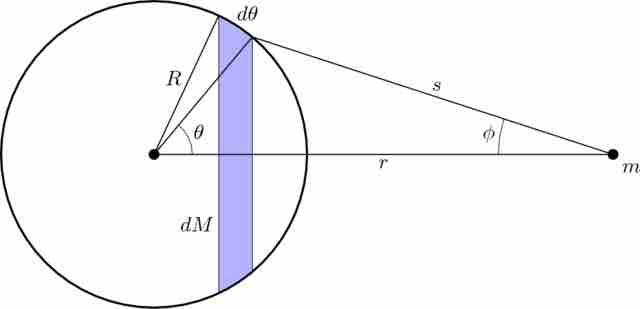Universal Gravitation for Spherically Symmetric Bodies
The Law of Universal Gravitation states that the gravitational force between two points of mass is proportional to the magnitudes of their masses and the inverse-square of their separation,
However, most objects are not point particles. Finding the gravitational force between three-dimensional objects requires treating them as points in space. For highly symmetric shapes such as spheres or spherical shells, finding this point is simple.
The Shell Theorem
Isaac Newton proved the Shell Theorem, which states that:
- A spherically symmetric object affects other objects gravitationally as if all of its mass were concentrated at its center,
- If the object is a spherically symmetric shell (i.e., a hollow ball) then the net gravitational force on a body inside of it is zero.
Since force is a vector quantity, the vector summation of all parts of the shell/sphere contribute to the net force, and this net force is the equivalent of one force measurement taken from the sphere's midpoint, or center of mass (COM). So when finding the force of gravity exerted on a ball of 10 kg, the distance measured from the ball is taken from the ball's center of mass to the earth's center of mass.
Given that a sphere can be thought of as a collection of infinitesimally thin, concentric, spherical shells (like the layers of an onion), then it can be shown that a corollary of the Shell Theorem is that the force exerted in an object inside of a solid sphere is only dependent on the mass of the sphere inside of the radius at which the object is. That is because shells at a greater radius than the one at which the object is, do not contribute a force to an object inside of them (Statement 2 of theorem).
When considering the gravitational force exerted on an object at a point inside or outside a uniform spherically symmetric object of radius
Case 1: A hollow spherical shell
The gravitational force acting by a spherically symmetric shell upon a point mass inside it, is the vector sum of gravitational forces acted by each part of the shell, and this vector sum is equal to zero. That is, a mass
The net gravitational force that a spherical shell of mass

Diagram used in the proof of the Shell Theorem
This diagram outlines the geometry considered when proving The Shell Theorem. In particular, in this case a spherical shell of mass
Case 2: A solid, uniform sphere
The second situation we will examine is for a solid, uniform sphere of mass
where it can be shown that
(
Therefore, combining the above two equations we get:
which shows that mass
As in the case of hollow spherical shells, the net gravitational force that a solid sphere of uniformly distributed mass